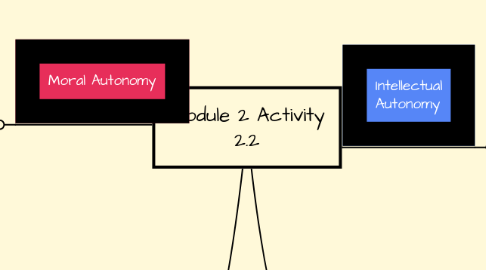Module 2 Activity 2.2
by Michaela Hartman


1. Moral Autonomy
1.1. Older children tend to be more autonomous than younger children., although rarely are even adults truly moral.
1.2. If adults speak with children in a way that shows the children different points of view, then they are more likely to become more autonomous and realize that honesty is the way to go.
1.3. If the focus of discipline is punishment, the child will not learn how they could better handle the situation, they will only learn how to not get caught.
1.4. "A vast difference exists between autonomy and revolt."
1.5. Instead of children developing autonomy, punishment simply secures them within heteronomy.
1.6. 4 Types of Sanctions By Reciprocity
1.6.1. 1. Temporary or permanent exclusion from the group
1.6.2. 2. Calling the child’s attention to the direct and material consequence of his or her act
1.6.3. 3. Depriving the child of the thing that he or she misused
1.6.4. 4. Restitution
2. Autonomy as the Aim of Education
2.1. The focus should not be on memorization. Students will simply memorize the information for a test and then forget these facts. This is not the way for autonomy to be established.
2.1.1. Research and prepare experiment
2.2. Students who are kept in an environment filled with heteronomy, they are not able to develop autonomy.
3. Intellectual Autonomy
3.1. It is important for the teacher to take the focus off of the answer and focus on the process of how a child reaches that answer. In this strategy, the students will learn how to problem-solve, as well as, trust themselves and think for themselves.
3.1.1. Text book p. 55-60
3.1.2. Joseph Conrad "Heart of Darkness"
3.2. As a child matures, he or she will become more autonomous and develop her own ideas about how the world works and what life is all about.
3.3. Main focus for the lessons for students should be games that practice sums, and not worksheets that practice sums.
4. Teaching for Autonomy
4.1. Allow class discussions that promote learning, not necessarily right answers. If a student originally states the wrong answer, help him or her understand why it is wrong, until the child sees the answer wrong, himself. This is how the teacher promotes autonomy in the classroom.
4.1.1. Midterm
